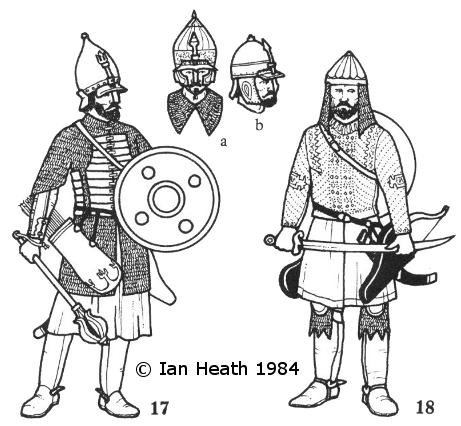
Join Amazon Prime - Watch Thousands of Movies & TV Shows Anytime - Start Free Trial Now
MAMLUKS IN ARMOUR, 14th-15th CENTURIES
An extract from Armies of the Middle Ages, Volume 2by Ian Heath
 |
|

 |
|
17 & 18. MAMLUKS IN ARMOUR, 14th-15th CENTURIES
The two principal modes of mamluk armour, comprising the djawshan and the kazaghand, can be seen quite clearly in these figures. The djawshan was a coat-of-mail reinforced with iron splints (teneke) identical to the Ottoman korazin, for which see figures 8 and 9. The use of this type of armour, which was introduced in the 13th century, steadily increased throughout this period, but even in the 15th century it was still used almost exclusively by amirs, amongst whom it was very popular. That worn by figure 17 has an opening down the front, joined together by hooks and buckles, while others had openings down the side. The laminae were often stamped or inlaid with ornamental patterns or inscriptions, as too were helmets, the inlay sometimes being gilt. Ordinary mail corselets (zardiya) remained in use too. Al-Maqrizi records that in the 14th century some were very long, the word ‘dragging’ tending to suggest they could perhaps be ankle-length. In the late-15th century Circassian coats-of-mail often had large collars as depicted in 17a.
The kazaghand worn by 18 is based on the only known surviving example, in the Muzeo Nazionale in Florence and dating to c. 1438-56. It is a short jacket of brigandine construction, made of very strong material covered in crimson velvet and peppered with brass nails. By the beginning of the 15th century such a corselet was usually called a karkal, Qalqashandi describing it at that time as made of iron laminae covered with red or yellow brocade, silk or velvet, while Taghribirdi and other sources indicate that, unlike the Florentine example, it was usually sleeveless. We are also told that Mamluk soldiers using firearms (presumably including handgunners) wore karkals, in their case somewhat less plush than those of the socially superior cavalry, being covered in bolas (seemingly some sort of hair-cloth) rather than silk or velvet. It would seem that by c. 1400 at the latest the karkal was the most common form of Mamluk armour. Qalqashandi observed at the beginning of the 15th century that though mail corselets had once been widely worn, by that time the karkal prevailed instead, and in 1422 Gilbert de Lannoy described typical Mamluk armour as comprising a ‘silk-covered corselet’. Nevertheless, older styles of armour took a long time to entirely disappear, since it was customary for the equipment of deceased mamluks to be redistributed amongst their comrades-in-arms.
Additional items of armour comprised bazubands and mail and plate thigh and knee armour, both of Persian/Turkish type. The shins were normally left unarmoured, the thick khuff boots presumably being regarded as adequate protection, but by the 15th century a mail and plate ‘boot’ was sometimes worn.
According to Qalqashandi 2 principal types of helmet were in use in Mamluk Egypt in the earlier part of this period, comprising the baida (‘egg’) protecting only the head, and the mighfar, worn by 18, which had a mail avantail attached by vervelles to its lower edge to protect the neck and ears, and sometimes a nasal. A third, much older, type also known to have survived into the 14th century replaced the avantail with a plate neck-guard. During the 15th century at the latest 2 additional types of helmet also appeared and thereafter predominated amongst amirs, these being the kawnas and the muwa’ama. An early example of the former worn by 17 (that of Sultan Barsbay, 1422-38) demonstrates its principal characteristics, which were that it was tall and had a peak, nasal, neck- and ear-guards. That shown in 17a is a later example, dating to the second half of the 15th century. The more rounded muwa’ama gradually replaced the kawnas, closely resembling later 16th century European types. 17b depicts that of Khairbak, last Mamluk governor of Aleppo, dating to c.1515. Turban helmets such as are described and depicted under 9b were probably also worn, H. Russell Robinson’s Oriental Armour including a photograph of a 15th century Mamluk turban helmet. A late-14th century military manual describes Mamluk helmets as being worn with a padded lining buttoned inside, perforated to ‘diffuse the substance of the blow’, and late Circassian sources speak of helmets being fastened with a leather strap buckled under the chin.
Both figures carry round wooden or iron shields with guige-straps, though a small number of kite-shields may also have remained in use into the early Circassian period. They are armed with the conventional Mamluk combination of sword, mace, lance and bow, Arnold von Harff reporting that each Mamluk took 2 bows with him on campaign. To judge by surviving examples the sword remained largely straight, though many ms. illustrations show slightly curved blades (see, for example, figure 16) and the scimitar was in use too from the early-14th century. L. A. Mayer says that scabbards were of wood covered in leather, shagreen, damask, velvet or metal, those for curve-bladed swords opening ‘spring fashion’ at the back near the top. Another type of sword called a ghaddara, mistakenly described by Mayer as a ‘steel staff’ was kept in a scabbard at the saddle. This was the Persian quaddara, a broad, long, straight-bladed sword which had parallel edges for most its length; it is probably this same weapon that Pero Tafur intended by his description of Ottoman cavalrymen carrying ‘an iron staff’ at the saddle. Ibn Iyas records that the use and manufacture of the ghaddara was, curiously, prohibited after 1512 by the Mamluk sultan Qansuh al-Ghawri.